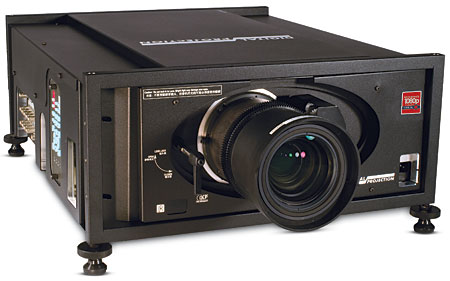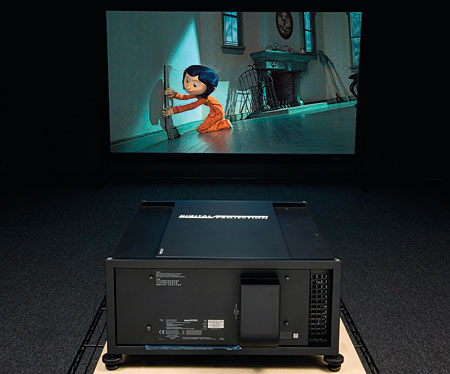Digital Projection Titan 1080p 3D
Tell me you’ve never imagined what you’d do first if you won the lottery. Even if you never play and you know you have a better chance of getting hit by lightning than winning $10 million or (it’s a dream, isn’t it, so why go small potatoes?) even $100 million. Sure, if you take it all at once rather than in $5 million drabs over 20 years, that will drop to $50 million out of the gate. After Uncle Sam gets his cut, you’re down to $25 million. There goes your chance to buy the Seattle Seahawks.

But not your chance for a killer home theater rig. Yes, you can get an impressive home theater projector for less than $10,000. Throw in a reasonably sized screen, an audio system, and a popcorn maker, and you’re still on the south side of $20,000. But for a multimillionaire like you, even after the tax man cometh, that’s pocket change. Why not go for it?
For starters, you can pop for a professional-quality video projector that can drive a very large screen. We’re talking the full Hollywood screening-room experience at home. A projector like the Digital Projection Titan 1080p 3D. Like all such projectors, the Titan isn’t designed for over-the-counter sales and do-it-yourself home theater fans. It’s available only through experienced custom installers.
The Big Parade
Digital Projection is a company that specializes in big projectors intended mainly for serious professional venues such as theaters, theme parks, and concert venues. It’s a British firm (I figured that out when I found that the manual read colour whilst it discussed color) that was founded in 1989. It introduced the first three-chip DLP projector to the market in 1997, and all of its current products employ this technology. The company is also the only projector manufacturer to have earned an Emmy (two of them, actually) from the Academy of Television Arts and Sciences for Outstanding Achievement in Engineering Development.

The Titan 1080p 3D is the top overall performer (though not the brightest) in Digital Projection’s Titan range. (From here forward, I’ll refer to the Titan 1080p 3D as simply the Titan.) It too is a three-chip, dual-lamp model with light output specified at 4,500 ANSI lumens. That’s almost unheard of with consumer projectors, where this rating is rarely higher than 2,000 ANSI lumens—and often far less.
A wide range of separately priced lenses is available for the Titan. All of them are from Minolta. We were sent the 1.87-2.56:1 High Contrast zoom, which is a medium throw on Digital Projection’s depth chart. The projector, together with any lens, lists for $84,995. Setup and delivery costs are between you and your installer. That lottery plan is looking better all the time.
It’s possible to use an anamorphic lens in front of the standard lens in 3D projection, and Digital Projection did so when it demonstrated its projectors to the local press and installers at Stewart Filmscreen’s Los Angeles facilities back in May. However, our setup here used a standard 1.78:1 screen, not a constant-height widescreen setup. In any event, the lens that Digital Projection sent me is an impressive assemblage of glass elements, and it makes the lenses found on most home projectors look like they just dropped in from a View-Master convention.
Stewart Filmscreen generously provided us with a 118-inch-wide, 16:9 StudioTek 130 screen (white, 1.3 gain) for this report. Digital Projection also sent along a Samsung BD-C6900 Blu-ray 3D player for us to use with the projector and three pair of 3D active shutter glasses from XpanD. The glasses are triggered from an outboard IR emitter that connects to the projector. Because the size of the viewing audience for this type of installation is often more than three or four people, multiple emitters may also be used.

We set up the Titan at 18.5 feet from the screen. Or to put it more accurately, the Digital Projection tech who came in the box (not really) did most of the setup work while I watched.
The projector employs two separate, 300-watt Mercury lamps that are filtered to produce a Xenon-like color balance. The lamps are rated for 2,000 hours, and replacements cost $1,195 each. You can elect to shut off either one of these lamps when one is sufficient. There’s also a mode that uses a single lamp. It automatically alternates between the lamps every time you turn on the projector. You can also electronically lower each lamp’s light output by about 15 percent (from a setting of 100 percent to 85 percent, or any point in between), although I didn’t do so for this report.
With the two lamps cooking at maximum, the Titan sucks just over 900 watts from your power line, and just a bit over 500 watts in single-lamp mode. Pray that the carbon police don’t get better organized.





























































